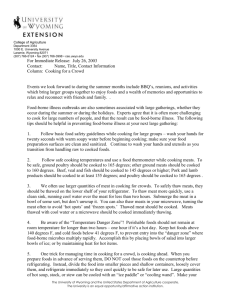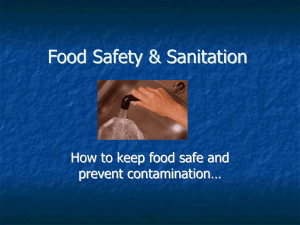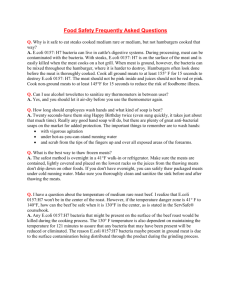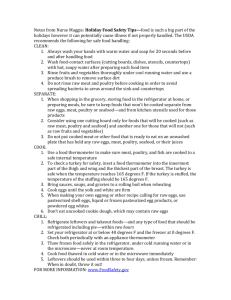U Guide to Food Safety - University of Bath Students' Union
advertisement
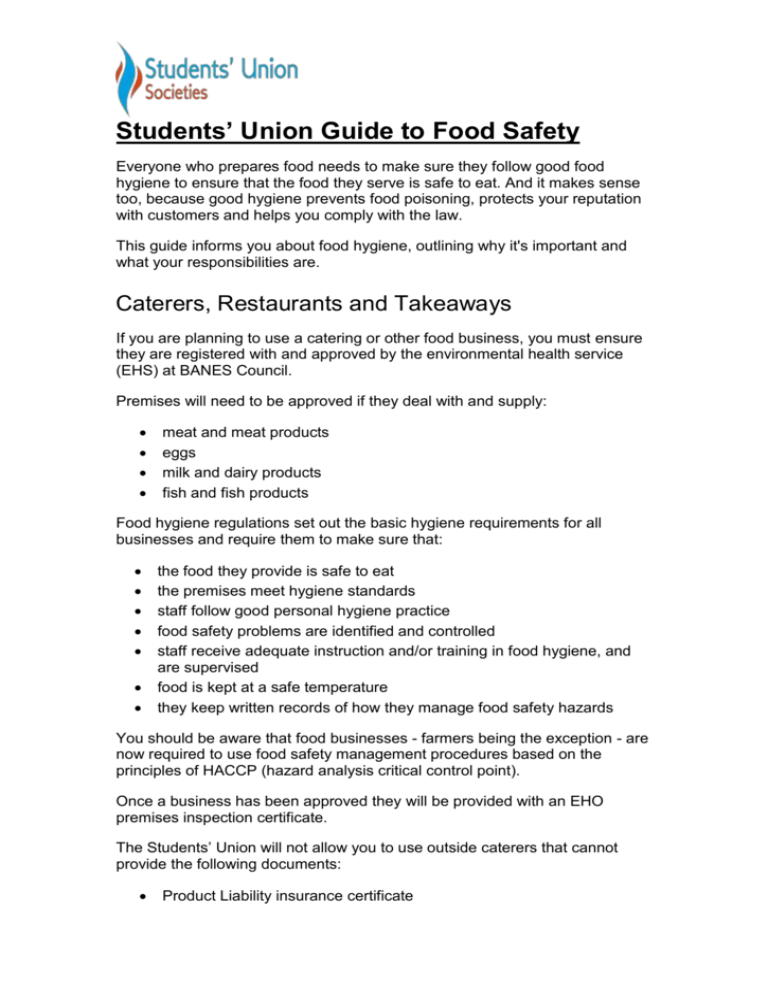
Students’ Union Guide to Food Safety Everyone who prepares food needs to make sure they follow good food hygiene to ensure that the food they serve is safe to eat. And it makes sense too, because good hygiene prevents food poisoning, protects your reputation with customers and helps you comply with the law. This guide informs you about food hygiene, outlining why it's important and what your responsibilities are. Caterers, Restaurants and Takeaways If you are planning to use a catering or other food business, you must ensure they are registered with and approved by the environmental health service (EHS) at BANES Council. Premises will need to be approved if they deal with and supply: meat and meat products eggs milk and dairy products fish and fish products Food hygiene regulations set out the basic hygiene requirements for all businesses and require them to make sure that: the food they provide is safe to eat the premises meet hygiene standards staff follow good personal hygiene practice food safety problems are identified and controlled staff receive adequate instruction and/or training in food hygiene, and are supervised food is kept at a safe temperature they keep written records of how they manage food safety hazards You should be aware that food businesses - farmers being the exception - are now required to use food safety management procedures based on the principles of HACCP (hazard analysis critical control point). Once a business has been approved they will be provided with an EHO premises inspection certificate. The Students’ Union will not allow you to use outside caterers that cannot provide the following documents: Product Liability insurance certificate BANES council food hygiene certificate Latest EHO premises inspection document Food Preparation Food hygiene: cleaning and cross-contamination Cleaning and preventing cross-contamination are both essential to make sure the food you serve is safe to eat. Effective cleaning gets rid of bacteria on hands, equipment and surfaces, which helps to stop harmful bacteria from spreading onto food. You should: make sure that everyone who handles food washes their hands before starting work, after a break, after going to the toilet, after emptying a bin and before starting a new task clean food areas and equipment between different tasks, especially after handling raw food clean as you go, mopping up spills as they happen use appropriate cleaning products and follow the manufacturer's instructions prevent food waste building up Cross-contamination is when bacteria spread between food, surfaces or equipment. It's most likely to happen when: raw food touches or drips onto other food raw food touches or drips onto equipment or surfaces people touch raw food with their hands For example, if raw meat drips onto ready-to-eat food in the fridge, bacteria will spread from the meat to the food. If you cut raw meat on a chopping board, harmful bacteria will spread from the meat to the board and knife. If you then use the same board and knife without washing them thoroughly - to prepare ready-to-eat food, such as salad, the bacteria will spread from the board and knife to the food. Hands and cloths can also spread bacteria. So remember to: keep raw and ready-to-eat foods separate wash your hands thoroughly after touching raw food clean surfaces and equipment thoroughly before you start to prepare food and after they have been touched by raw food Food hygiene: cooking and chilling safely Cooking and chilling are both essential to make sure the food you serve is safe to eat. Cooking Thorough cooking kills harmful bacteria in food; therefore, don't serve any food that isn't sufficiently cooked - once food is cooked, serve it immediately or keep it hot until serving. If you're cooking food in advance, cool and chill it quickly. Thawing: Thaw uncooked meat in the refrigerator or in cold water. NEVER thaw meat at room temperature. Marinating: Marinate food in the refrigerator, not on the counter. Discard the marinade after use because it contains raw juices, which may harbour bacteria. If you want to use the marinade as a dip or sauce, reserve a portion before adding raw food. Partial Cooking or Browning: Never brown or partially cook meat, then refrigerate and finish cooking later, because any bacteria present would not have been destroyed. It is safe to partially precook or microwave meat immediately before transferring it to a hot grill or oven to finish cooking. Cooking: Use a food thermometer EVERY time you cook raw foods; reheat leftovers; and hold hot, cooked foods for serving. Serving: Hold hot foods above 140 °F and cold foods below 40 °F. Never leave foods, raw or cooked, at room temperature longer than two hours. On a hot day with temperatures at 90 °F or warmer, this decreases to one hour. Leftovers: Always use clean utensils and storage containers for safe storage. Divide large amounts of leftovers into small, shallow containers for quick cooling in the refrigerator. Avoid placing large pots of gravy or stew in the refrigerator to cool since it will likely take until the next day for this amount of food to cool. To store in the refrigerator, wrap cooked meat in plastic wrap or aluminium foil, or store it in a tightly covered container and use within two to three days. For frozen storage, wrap meat in heavy duty aluminium foil or freezer paper and use within two to three months. If you may have kept the food refrigerated for too long, throw it out. Never taste food that looks or smells strange to see if you can still use it. Reheating Foods: Reheat thoroughly to a temperature of 165 °F or until hot and steaming. Soups and gravies should be brought to a rolling boil. Barbequing Foods: Barbequed meat can look cooked when it isn’t cooked through. Always use a thermometer to check. Never part-cook on a BBQ and finish cooking later. However, you can part-cook poultry in the kitchen before you cook on the BBQ. To light the BBQ always us proper BBQ lighter fuel and not petrol or other flammable liquids. If using a gas BBQ ensure the gas lights immediately. If the gas fails to light on the first or second attempt turn off the gas for a few minutes before trying again. Position BBQ’s on level ground away from fences, hedges and tree or anything that could catch fire. Ensure you have sufficient food preparation and serving areas. Microwaving Foods: Microwave ovens can cook unevenly and leave “cold spots” where harmful bacteria can survive. For this reason, it is important to use the following safe microwaving tips to prevent food-borne illness when cooking or reheating meat. Debone large pieces of meat. Bone can shield the meat from thorough cooking. Do not cook large cuts of meat on high power (100%). Cook large pieces of meat on medium power (50%) for longer times. This allows heat to conduct deeper into meat without overcooking outer areas. Stir or rotate food once or twice during microwaving, and turn large food items upside down so foods cook more evenly and safely. When microwaving unequal size pieces of meats, arrange in a dish or on a rack so thick parts are toward the outside of the dish and thin parts are in the centre. Cook on medium-high or medium power. Place a roast in an oven-cooking bag or in a covered pot for safe, even cooking. Do not microwave whole, stuffed poultry. Cooking of meats is so rapid, the stuffing inside might not reach a sufficient temperature to be safe. Refer to the manufacturer’s directions that accompany the microwave oven for suggested cooking times. Observe standing times so cooking is completed. Then remove from microwave and test in several places with a thermometer to check the food has reached a safe minimum internal temperature. Never partially cook food. When microwaving food to finish cooking on the grill or conventional oven, transfer the microwave food to another heat source immediately. Remove meat from packaging before defrosting. Do not use foam trays and plastic wraps, which are not heat stable at high temperatures. Melting or warping may cause harmful chemicals to migrate into food. Cook meat, poultry and fish immediately after defrosting in the microwave oven because some areas of the frozen food may begin to cook during the defrosting time. Only use cookware that is specially manufactured and labelled for use in the microwave oven. Do not use margarine tubs, take-out containers, whipped topping bowls and other one-time use containers in microwave ovens. These containers can warp or melt, possibly causing harmful chemicals to migrate into the food. Microwave plastic wraps, wax paper, cooking bags, parchment paper, and white microwave-safe paper towels should be safe to use. Do not let plastic wrap touch foods during microwaving. Thermometers For safety, food must be cooked thoroughly. It is essential to use a thermometer when cooking meat to take the guesswork out of cooking and to assure that a safe temperature has been reached to destroy harmful bacteria such as Salmonella and E.coli O157:H7. Using a thermometer is the only reliable way to ensure safety and to determine the “doneness” of most foods. To be safe, a product must be cooked to an internal temperature high enough to destroy any harmful bacteria that may have been in the food. A thermometer should also be used to ensure that cooked foods are held at a safe temperature (below 40 °F or above 140 °F) until served. Recent research has shown that colour and texture changes are not reliable indicators that all bacteria have been destroyed. For example, ground beef may turn brown before it has reached a temperature that will destroy bacteria. The temperature at which different pathogenic bacteria are destroyed varies, as does the “doneness” temperature for different meat and poultry products. A roast or steak that has never been pierced in any way during slaughter, processing or preparation that has reached an internal temperature of 145 °F is safe to eat. Tips for Thermometer Use: Use an “instant-read” thermometer to check temperatures. They are designed to be used toward the end of cooking time and register a temperature in about 15 seconds. If a the meat is not thick enough to check from the top, insert the thermometer in sideways. The thermometer should penetrate the thickest part of the food. To check the calibration, place the stem in ice water as described below. Most thermometers have a calibration nut under the dial that can be adjusted. Thoroughly wash the thermometer after each use. Recommended Internal Temperatures for Meat Most pathogenic bacteria are destroyed between 140 °F and 160 °F, but the recommendations for thorough cooking varies between the type of meat or poultry. See the table below for minimum recommended internal temperatures. Ground meats must be cooked thoroughly to kill harmful bacteria. Unlike whole muscle meat, which is sterile inside, the grinding process exposes the interior meat to bacteria on the surface, in the air, on equipment or on people’s hands. To kill these bacteria, you must cook ground meat to at least 160 °F. Minimum Internal Temperatures These temperatures ensure that food-borne bacteria have been destroyed. For reasons of personal taste or texture preferences, consumers may choose to cook meat and poultry to higher temperatures. 145 °F Beef, lamb and veal steaks, roasts and chops cooked medium rare (cooked medium to 160 °F). Fish. 160 °F Egg dishes. Ground beef, veal and lamb. Pork, all cuts. 165 °F Leftovers. Poultry. Stuffing and casseroles. Calibrating a Thermometer A food thermometer can be checked for accuracy using either the ice water method or the boiling water method. The ice water method is explained below. Many food thermometers have a calibration nut under the dial that can be adjusted. Check the packaging for instructions. Ice Water Method: To use the ice water method, fill a large glass with finely crushed ice. Add clean, cold tap water to the top of the ice and stir well. Immerse the food thermometer stem a minimum of 2 inches into the mixture, touching neither the sides nor the bottom of the glass. Wait a minimum of 30 seconds before adjusting. (For ease in handling, the stem of the food thermometer can be placed through the clip section of the stem sheath and, holding the sheath horizontally, lowered into the water.) Without removing the stem from the ice, hold the adjusting nut under the head of the thermometer with a suitable tool and turn the head so the pointer reads 32 °F. Even if the food thermometer cannot be calibrated, it should still be checked for accuracy. Any inaccuracies can be taken into consideration when using a food thermometer or it can be replaced. For example, ground beef burgers must reach 160 °F. If the thermometer is reading two degrees too high, two degrees would be added to the desired temperature, meaning hamburger patties must be cooked to 162 °F. Chilling Chilling food stops bacteria from growing and multiplying. Some foods need to be kept chilled to keep them safe - for example food with a "Use by" date, food that you have cooked and won't serve immediately, or other ready-to-eat food such as prepared salads. Follow these guidelines for food chilling: put food that needs to be kept chilled in the fridge straight away cool cooked food as quickly as possible and then put in the fridge keep chilled food out of the fridge for the shortest time possible during preparation keep chilled food cold when it's on display don't overload fridges Food Safety: allergies Some people have very severe allergies to certain foods. Such allergies can be life threatening, even if the allergic person eats just a very tiny amount of the food. Foods that can cause severe allergic reactions include peanuts and other nuts (including Brazil nuts, hazelnuts, almonds, walnuts, cashews and pecans), milk, eggs, fish, shellfish (including mussels, clams, crabs and shrimps), soya, sesame seeds, lupin and gluten (which is found in wheat, rye and barley). It is especially important to know which of your dishes contain these foods, so you can pass this information on to your customers or employees. All foods that may contain any of the above should be clearly labeled. Remember, even a tiny amount can cause a severe reaction in someone who is sensitive. In case a customer asks about the ingredients of a meal, make sure there is always someone on duty who knows or can find out the ingredients of all the foods you provide. Remember that this will include individual ingredients of all the foods, sauces and seasonings you have used. If you are not sure whether a meal contains the food that the customer is asking about, say you are not sure. Never guess. If a dish contains one of the foods listed above, make sure this is reflected in the name or the menu description, for example "carrot and nut salad". If you think someone is having a severe allergic reaction, do not move them ring 999, explain that you think they are having an allergic reaction and ask for a paramedic.
